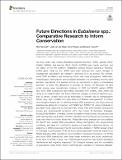Files in this item
Future directions in Eubalaena spp. : comparative research to inform conservation
Item metadata
| dc.contributor.author | Harcourt, Rob | |
| dc.contributor.author | van der Hoop, Julie | |
| dc.contributor.author | Kraus, Scott | |
| dc.contributor.author | Carroll, Emma L. | |
| dc.date.accessioned | 2019-01-30T13:30:04Z | |
| dc.date.available | 2019-01-30T13:30:04Z | |
| dc.date.issued | 2019-01-30 | |
| dc.identifier | 257558282 | |
| dc.identifier | 6cb27b98-3fa2-4fd1-af27-d61226068ac1 | |
| dc.identifier | 85066026290 | |
| dc.identifier | 000457826000001 | |
| dc.identifier.citation | Harcourt , R , van der Hoop , J , Kraus , S & Carroll , E L 2019 , ' Future directions in Eubalaena spp. comparative research to inform conservation ' , Frontiers in Marine Science , vol. 5 , 530 . https://doi.org/10.3389/fmars.2018.00530 | en |
| dc.identifier.issn | 2296-7745 | |
| dc.identifier.other | RIS: urn:FB8415E3D92EEBF6681B1327C1FCB6F4 | |
| dc.identifier.uri | https://hdl.handle.net/10023/16962 | |
| dc.description.abstract | All three extant right whales [Eubalaena australis (Southern; SRW), glacialis (North Atlantic; NARW), and japonica (North Pacific; NPRW)] were heavily exploited, and the status of the two northern hemisphere species remains precarious. Recently, limited gains made by the NARW have been reversed and urgent changes to management approaches are needed if extinction is to be averted. By contrast, some SRW populations are recovering. Given their close phylogenetic relationship, morphological, demographic, and ecological similarities, the contrasting recovery rates between populations and species provide an opportunity to apply a comparative approach to inform the differences in recovery as follows. (1) Recovery: All right whale species were internationally protected in 1931, but NARW, eastern NPRW and some SRW populations have barely recovered from whaling, while others are doing so at maximal rates. Are these differences a legacy of extreme depletion (e.g., loss of genetic diversity and cultural knowledge) or primarily due to anthropogenic factors (e.g., high mortality from ship strike and fisheries entanglement)? If modern anthropogenic threats are not affecting remote SRW populations, can these serve as baseline populations for comparison with NARW and NPRW? (2) Linking individuals to population-level responses: In wild mammals, strong links exist between reproductive indices and environmental conditions within the context of life-history strategies. Individual identification of whales provides the ability to track survival, reproduction and other demographic parameters, and their population-level consequences, providing the tools with which to uncover these links. Robust life-history analyses are now available for NARW and several SRW populations, linking demography with environmental conditions, providing the potential for teasing out important influencing factors. (3) Adapting to shifting resources: Recent reproductive declines in NARW appear linked to changing food resources. While we know some large-scale movement patterns for NARW and a few SRW populations, we know little of mesoscale movements. For NPRW and some SRW populations, even broad-scale movements are poorly understood. In the face of climate change, can methodological advances help identify Eubalaena distributional and migratory responses? (4) Emergent diseases and the vulnerability of populations under stress: Marine mammals are vulnerable to infectious diseases, particularly when subjected to stressors such as fishing gear entanglements, acoustic disturbance, and prey shortages. New tools to assess large whale health include body condition imaging, viromes, microbiomes, as well as metabolic and stress hormones. Comparative analysis of the three Eubalaena spp. could identify causes of varying recovery. (5) Comparative synthesis and cumulative effects: The lack of a good analytical approach for cumulative effects is an urgent bio-statistical problem in conservation biology. Without such a framework every stressor is managed in isolation, limiting efficacy. We propose a comparative synthesis to inform future cumulative effect analyses and outline future research priorities to achieve these goals. | |
| dc.format.extent | 25 | |
| dc.format.extent | 1449064 | |
| dc.language.iso | eng | |
| dc.relation.ispartof | Frontiers in Marine Science | en |
| dc.subject | Right whale | en |
| dc.subject | Conservation | en |
| dc.subject | Cumulative effects analysis | en |
| dc.subject | Conservation technology | en |
| dc.subject | Threats | en |
| dc.subject | Recovery | en |
| dc.subject | QH301 Biology | en |
| dc.subject | T-NDAS | en |
| dc.subject | SDG 3 - Good Health and Well-being | en |
| dc.subject | SDG 13 - Climate Action | en |
| dc.subject | SDG 14 - Life Below Water | en |
| dc.subject.lcc | QH301 | en |
| dc.title | Future directions in Eubalaena spp. : comparative research to inform conservation | en |
| dc.type | Journal article | en |
| dc.contributor.institution | University of St Andrews. School of Biology | en |
| dc.contributor.institution | University of St Andrews. Sea Mammal Research Unit | en |
| dc.identifier.doi | 10.3389/fmars.2018.00530 | |
| dc.description.status | Peer reviewed | en |
This item appears in the following Collection(s)
Items in the St Andrews Research Repository are protected by copyright, with all rights reserved, unless otherwise indicated.

